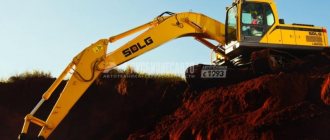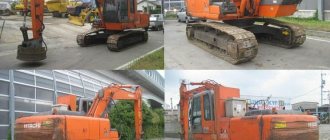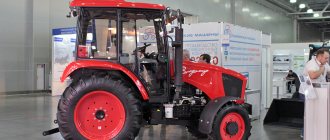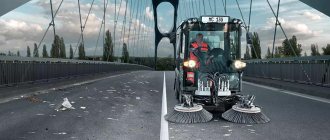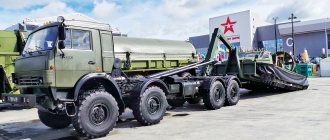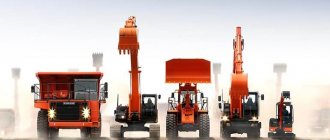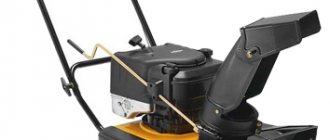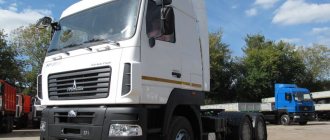Growing competition requires road construction companies to use the most efficient special equipment to carry out work. Achieving success with an ancient bulldozer and a roller from the USSR is now possible only in a remote province. Contractors from large Russian cities prefer to purchase modern models of special equipment for road construction.
Preference is given to the world's leading brands (Bomag, Caterpillar, VOLVO, Ammann and others). Models from these manufacturers are available to Russian companies in a wide range. All brands are constantly introducing new lines with updated engines and performance parameters. Among the modern mechanisms and units for performing road construction work are:
- soil compaction rollers;
- tandem rollers;
- road milling machines;
- asphalt concrete pavers;
- asphalt mixing plants;
- graders;
- vibrating plates and vibrating rammers;
- recyclers.
The features and parameters of modern models of road equipment will be discussed below.
Compact compaction rollers
Models from Ammann, Bomag and Hamm weigh from 3 to 7 tons. They are characterized by compactness, a short wheelbase and a 1700 mm wide drum. The seven-ton Bomag BW 177 D-5 and BW 177 DH-5 have a drum extended to 1900 mm, which increases productivity by 11 percent.
Separately, it is worth highlighting the Bomag BW 11 RH-5 with a turning radius of 2.7 meters. This makes it possible to compact asphalt or soil in limited areas. The compaction quality is ensured by smooth start and stop. To control the rollers there are special backlit panels with a logically organized button structure.
Do you want to buy sand or crushed stone with delivery?
Call now and get a discount +7 (988) 318-84-49
Equipment for modifying bitumen and preparing bitumen emulsion
A very important technological operation is the modification of bitumen with polymers, which is carried out through the use of USB-2 type installations of the GlobeCore trademark. They make it possible to obtain bitumen and, as a result, asphalt concrete mixtures with specified properties, which helps to increase the service life of road pavements.
For the production of bitumen emulsions, special installations such as USB-1 of the GlobeCore brand are used. With their help, both cationic and anionic bitumen emulsions are prepared, which are then used in the construction and repair of asphalt roads.
Tandem rollers
They are full-size representatives of the ARX class. Produced by most well-known brands. The weight of the rollers is 14-16 tons with a drum diameter of 1100 to 1400 mm. The larger diameter helps prevent wave formation when laying sensitive polymer-modified mixtures.
Standard operating functions are:
- possibility of simultaneous operation with two frequencies and two amplitudes;
- sealing at the junctions of hot and cold mixtures;
- work near buildings, in hard-to-reach places or on bridges (oscillation).
Modern models are also equipped with systems for determining the degree of asphalt compaction. This allows you to save on unnecessary machine passes.
Road milling machines
The working width is from 0.5 to 2 meters. the Bomag BM2000/75 road milling machine is 36 tons. The compact road milling machine Wirten W 50 Ri has a working width of 0.5 meters. For high-quality cutting of the surface, it uses a leveling system. All models are equipped with multiple snare drums.
Typically a set consists of three cutters:
- For large cutting depths;
- Standard;
- Finishing (used to remove thin cracks on the surface, without replacing the coating).
Designers attach great importance to reducing dust levels, for which they use various systems, for example, spraying a binder directly in front of the drum.
Asphalt pavers
Available in a range from compact to super-heavy models. Their use significantly speeds up the speed of work, and leveling and pre-compaction systems make it possible to improve the quality of the canvas. Vögele has new models. These are the Super 1600-3i and Super 1603-3i (tracked and wheeled versions, respectively). They are compact machines and allow you to lay the mixture in a strip of 7 to 7.5 meters.
The super-heavy model Bomag BF-900C allows you to lay asphalt 13 meters wide. Also in this class are specialized models for laying sand, soil and lean concrete. They are equipped with reinforced conveyors and augers to minimize wear.
Snow removal
In urban conditions, the snow mass is moved by harvesting equipment into the tray area of the roadway for temporary storage. The formed shaft reduces the effective width of the roadway, eliminating most of the rightmost lane from use, and blocks intersections and junctions, which reduces the capacity of the city highway. It must be removed as soon as possible, and first of all at all intersections, transport stops, exits and other places determined individually for each work site. Breaks in the shafts are made by snow blowers and front loaders, which move the snow mass into the main shaft.
On those sections of highways where, due to the design of the transverse profile, the transfer of snow beyond the roadway is allowed, rotary snow blowers can operate. For the remaining length of the road, the snow bank must be removed and stored or disposed of.
After the work on the gaps is completed, a snow shaft is formed: a more compact shaft is created with a width at the base of up to 1.5–2 m, which is removed from the side of the sidewalk along the bottom by 0.3–0.5 m. This is necessary to improve the quality of the snow loader’s work , so when a snow loader picks up a snow bank with a shovel, less uncollected snow remains and the side stone is not damaged. The formation of snow banks is carried out by motor graders: either two machines moving sequentially, or one motor grader in two passes. During the first pass, the motor grader blade moves the snow bank lying close to the sidewalk towards the axis of the road; during the second pass, it moves toward the side of the sidewalk to create free space between the sidewalk and the snow bank.
Currently, road services are quite widely using the most highly productive snow loader of all, SNP-18. The loader has a rotary auger working body with a continuous belt conveyor in the form of a trench. Productivity – up to 600 m3/h. Loading height – 3.8–4.2 m, conveyor reach – 4.7 m.
A distinctive feature of this machine is that snow is loaded into the dump truck as it moves through the dump truck cabin. With this technology, the number of maneuvers is reduced; the driver of the dump truck moves only forward (reverse gear is excluded, as the most dangerous maneuver). Another advantage is that all work is carried out in the direction of travel.
Increasing the efficiency of technology for maintaining urban highways is associated with the development of applied sections of engineering and science, the introduction of new machines and technological processes proven by practice into the operating system. The indicators that are achieved with the introduction of scientifically based technology make it possible to increase labor productivity, reduce the cost of work and significantly improve their quality while complying with the necessary environmental requirements. In addition, it is necessary to take into account possible problems that arise during road maintenance even at the stage of designing transport facilities. This is especially acute for multi-level interchanges, since organizing their maintenance is a very serious problem for road maintenance services.
Asphalt mixing plants
This type of road special equipment can be called the pinnacle of modern technology. Highly mobile models are built on a modular basis. The plant uses up to 50 percent of the old coating, is quick to install and has low energy consumption. Equipment productivity ranges from 80 to 160 t/h. Special systems allow you to control drum performance and reduce losses at the beginning and end of the cycle. The Fayat Roadstar RS2500 model is installed without the use of cranes and has a capacity of 200 t/h. The basic elements are similar to other plants.
Compaction technology
The pace of development of the market for vibrating plates and vibratory rammers does not lag behind other types of road equipment. The Ammann APH 110-95 vibrating plate with a strip width of 950 mm has a hydrostatic drive, an operating weight of 825 kg and an penetration speed of up to 37 m/min. The advantage of this hydraulic vibrating plate is that the force can be adjusted based on the surface material and working conditions. The adjustment is made by changing the engine speed. The productivity of the vibrating plate is more than 2000 sq.m. surfaces per hour.
Volvo CE's intelligent compaction system allows you to calculate pavement density in real time. The basis of the system is a processor that makes calculations using a complex algorithm based on information from pressure sensors on the roller drum. Temperature sensors are also installed on the skating rink. The operator runs a 10-meter test strip, after which the processor automatically calibrates the force based on the material and conditions.
Snow removal technologies
The technology for clearing snow from city highways and high-category streets is determined by the following conditions.
• When performing technological operations for snow removal, it is necessary to ensure minimal interference with traffic. It is required to perform operations at a speed close to the speed of the traffic flow, as well as in the shortest possible time and number of passes.
• The value of the coefficient of adhesion between the wheel and the coating when using de-icing agents should ensure the safe movement of vehicles.
• The de-icing materials used must not have a harmful effect on the environment, and disposal of the snow mass must be carried out with minimal impact on the environment.
Upon receipt of meteorological information about the expected snowfall, before it begins, preventive distribution of liquid de-icing materials is carried out across the entire width of the roadway (Table 1).
When snowfall has already begun (if there is no forecast), solid reagents are distributed within an hour. During the movement of vehicles, the fallen snow is mixed with reagents, resulting in the formation of a snow mass. Table 1. Density of treating roads with liquid reagents in accordance with the current “Regulations for winter cleaning in Moscow”
| Reagent type | Unit | Reagent consumption at air temperature, °C | ||||
| 0…–2 | –2…–4 | –4…–6 | –6…–8 | –8…–10 | ||
| Liquid | ml/m2 | 25–35 | 35–45 | 45–55 | 60–70 | 70–80 |
| Liquid | g/m2 | 30–44 | 44–56 | 56–68 | 75–87 | 87–100 |
Further, depending on the intensity of snowfall and vehicle traffic, with every 2–3 cm of snow falling, the lack of reagent is compensated for by a new distribution of solid reagents.
The distribution density is determined by the air temperature (Table 2). Table 2. Density of treating roads with solid reagents in accordance with the current “Regulations for winter cleaning in Moscow”
| Reagent type | Unit | Reagent consumption at air temperature, °C | ||||
| 0…–2 | –2…–4 | –4…–6 | –6…–8 | –8…–10 | ||
| Solid | g/m2 | 20–30 | 30–50 | 50–60 | 60–70 | 70–80 |
Reagent distributors move along the roadway in a ledge, covering its entire width; the driver of each subsequent car controls the distribution of reagents along the border of the previous one. The first pass is carried out in the far right lane, where urban passenger transport routes pass; the second and subsequent passes process the remaining traffic lanes. The operating speed of modern distributors is up to 50 km/h with a possible reagent distribution width of up to 12 m. The time during which it is necessary to treat the roadway should not exceed 1 hour from the beginning of the technological treatment cycle on city main roads and central streets and 3 hours on district streets and local streets.
Next, snow plows begin work - they rake up the snow mass, and this work should be completed within 2 hours. When servicing district and local streets with low traffic intensity, the main means of mechanization to ensure the movement of vehicles in winter are KO-713 plow and brush snow plows , KDM-130 and similar machines. But their use on multi-lane highways with high traffic intensity is impractical due to the small width of the working area (2.3–2.5 m) and, as a consequence, the large required number of vehicles in the column. At the same time, the low operating speed (up to 25 km/h) creates the problem of many kilometers of traffic jams. The nature and importance of maintaining continuous traffic on wide express roads, such as the Moscow Ring Road and the 3rd Ring Road in Moscow, force road workers to look for other technologies using more powerful machines.
For high-speed cleaning of the Moscow Ring Road since the mid-1990s. Mercedes-Benz 2638A complex road vehicles are used. Their snow removal equipment includes a Schmidt Vector M front plow with a working width of 3200 mm at a 30° steering angle, and a GPS 5.3 side snow plow with a working width of 2370 mm (at a 40° steering angle). The height of the front blade is 920 mm, the side blade is 970 mm. The use of a side blade makes it possible to reduce the number of snow plows and provide the highest operating speed of 45–55 km/h when shoveling snow mass, which is close to the maximum speed of highways. MKDS vehicles based on MAZ or KamAZ vehicles are also widely used.
Before the main convoy of equipment enters the road to remove snow mass from the pavement surface, the elements of the axial fencing are first cleared of snow by a separate machine with a side manipulator on which a special brush is installed. In case of very intense and prolonged snowfalls, when in order to ensure the movement of vehicles it is necessary to quickly clear the road of the main volume of snow, a technological operation such as raking the snow mass is used. In this case, the snow is moved to the edge of the roadway only by plows, and the small layer remaining on the surface of the coating is swept away by subsequent passes or melted by reagents.
When raking snow, a column of six to seven wide-cut snowplows (enough to block the roadway on the Moscow Ring Road), equipped with front plows and side blades, ensures fast and high-quality single-pass cleaning of the highway surface and throwing the snow mass into the chute part. The width of the retractable strip MB 2638 (the first in the column) is 5.4–5.5 m, the subsequent ones are somewhat less due to the overlap of the track. After entering the highway, the column of cleaning equipment is lined up with a distance between individual snowplows of 15–20 m. This distance seems optimal from the point of view of the quality of cleaning, when the overlap is controlled by each subsequent driver, and this distance also prevents the convoy from being overtaken by passing vehicles. The fact is that as the distance increases and in the absence of a traffic police patrol car, the number of drivers trying to overtake the convoy by driving within the distance between snowplows increases, which leads to accidents and disruption of the cleaning process. Passing vehicles must not cross the snow bank formed by raking the snow mass.
The rightmost car in the column accounts for the largest volume of snow mass, shifted by other snowplows from the entire width of the roadway. It also bypasses stopped cars on the far right lane or side of the road, and it is advisable to carry out its working passage with the side blade retracted. This technological requirement ensures greater work safety. The column moves at a speed of 40–45 km/h. After raking, 1–1.5 cm of snow mass usually remains on the surface of the coating.
Next, following the column of snow removal equipment (synchronously), there are distributors of liquid or solid reagents, which treat the surface of the coating with the required density depending on the air temperature.
As 2–2.5 cm of snow mass accumulates on the surface of the coating or when the weather service reports the end of the snowfall, the final sweeping of the roadway is carried out, which can be carried out using several slightly different technologies.
• Sweeping with MB 2638 machines with the front blade replaced on the base by a front brush, but with a side blade in the working position. The front brush of the snowplow throws the snow mass from the right in the direction of travel onto the adjacent strip into a roller 1–1.5 m wide, which is intercepted by the side blade and thrown another 1.5–2 m into the working area of the next snowplow in the column.
• Sweeping by a column of machines consisting of MB 2638 with front brushes and domestic MKDS, which rake snow with blades and additionally sweep the coating with a central brush.
When the snowfall intensity is low, the mass of snow from the roadway to the tray part is simultaneously raked and swept away. The equipment of the machines is a single moldboard plow or frontal and side snow removal blades and a cylindrical brush. When a snow blower operates, the bulk of the snow is shifted to the side, and the remaining small layer is swept away with a brush.
Previously, before the sharp increase in traffic intensity on the Moscow Ring Road, it was possible not to sweep the surface with a brush, but now raking does not completely clear the roadway of snow. The reason here lies in the intensive formation of ruts on the asphalt concrete surface, from which the snow mass can only be removed using brushes.
The speed of the machines when sweeping reaches only 35–40 km/h, and to increase the throughput of the highway, the work technology provides for a gap between pairs of machines. Along the width of the brush passage, a clean “black” surface remains on the coating. After the column passes, depending on weather conditions, the roadway is treated with anti-icing agents. Thus, depending on the intensity of snowfall, there may be a different number of winter maintenance operations - from three to four (raking; sweeping; distribution of liquid reagents; distribution of solid reagents).
Graders
Modern achievements in this class of machines are well demonstrated by the Case C series models from Case Construction Equipment . They are equipped with a special SiteControl system for control. The designers focused on achieving maximum reliability, reducing operating costs, durability and versatility of use. The series consists of models weighing 13 and 16 tons in 6x4 and all-wheel drive 6x6 versions. The machines have a pressure compensation system that allows several operations to be carried out simultaneously. The equipment is also equipped with a leveling system. The company talks about a 15 percent increase in productivity.
Recyclers
The representative of the new generation of this class is Caterpillar RM500B . The machine combines high performance and ease of operation. The model is equipped with the function of stabilizing the soil, as well as removing and crushing old coating. The RM500B produces 546 hp. The cabin is equipped with vibration-isolating racks, which guarantees comfortable work. The engine drive is hydraulic. It includes 4 pumps and 4 motors, which ensures reliable grip on the surface. The working depth is adjusted automatically. The recycler has four steering modes and three rotor speed modes. The rotor in the mixing chamber moves independently.
As a conclusion
Developers of modern road equipment put technology first, constantly increasing the speed of their implementation. Today, innovation is no longer an empty sound in this industry. The latest models are much more economical, more environmentally friendly, save engine life, and independently avoid errors in operation. Ultimately, the operator’s work is greatly simplified and the time required to complete the task is accelerated.
Renting special equipment allows you to save time and money
If a contractor needs to use equipment that he does not have available, then renting construction equipment is the best option in terms of efficiency, simplicity and efficiency, especially if the machines are needed to perform a small list of tasks. We offer cost-effective solutions for our clients - with our help you can save time and money.
Diesel compressor Airman (PDS70S)
| Performance | 2.0 m3/min |
| Operating pressure | 7.0 kg/cm2 |
| Engine | 23 hp |
| Dimensions | 1600x750x865 mm |
PRICE: 600 rub/hour
ORDER
Backhoe loader JCB 3CX
| Digging depth | 5460 mm |
| Weight | 8445 kg |
| Bucket volume | 1 m3 |
| Engine power | 68.60 kW |
PRICE: 1250 rub/hour
ORDER
JCB JS130W wheeled excavator
| Digging depth | 4.775 m. |
| Bucket volume | 0.32 cu. m. |
| Maximum soil unloading height | 6655 mm. |
| Maximum speed | 32 km/h. |
PRICE: 1500 rub/hour
ORDER
JCB JS145W wheeled excavator
| Digging depth | 4.77 m |
| Bucket volume | 6.8 m |
| Boom Reach | 8.8 m |
| Unloading height | 30 km/h |
| Engine power | 125 hp |
PRICE: 1625 rub/hour
ORDER

